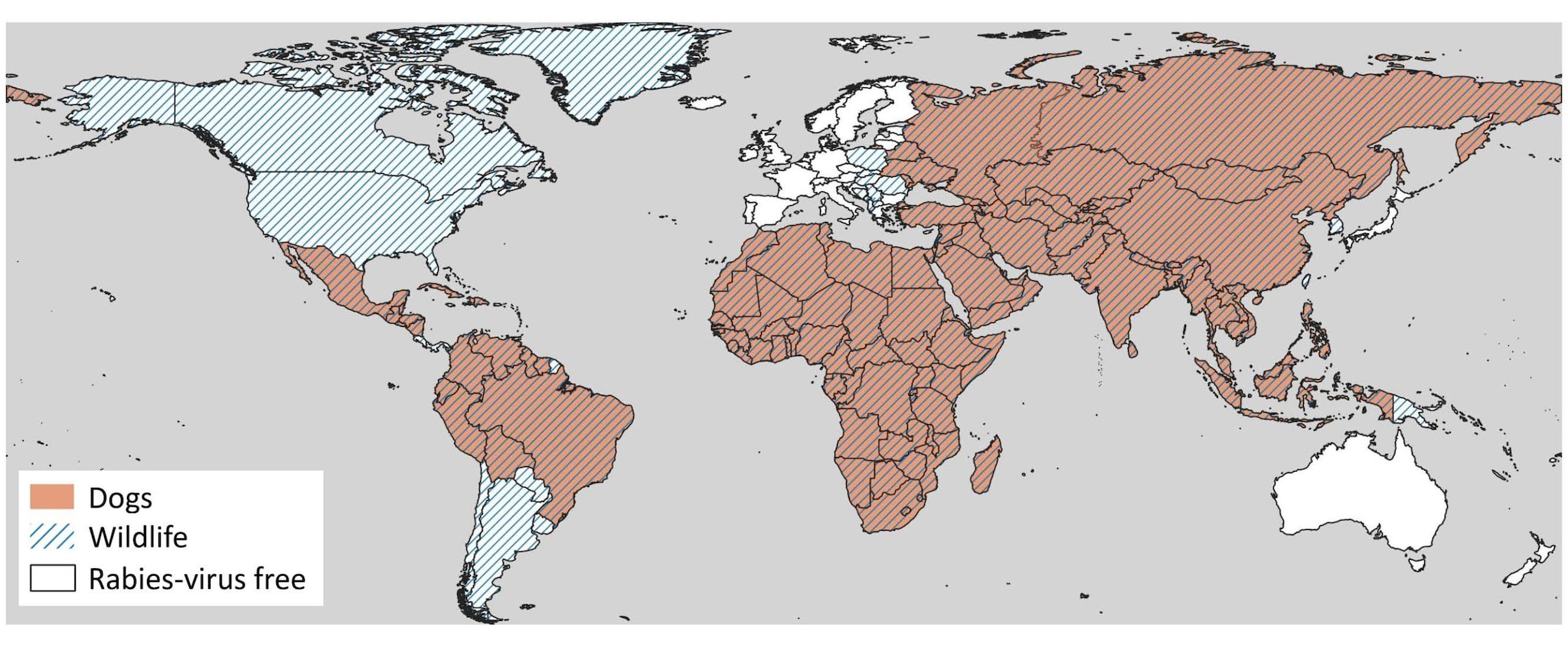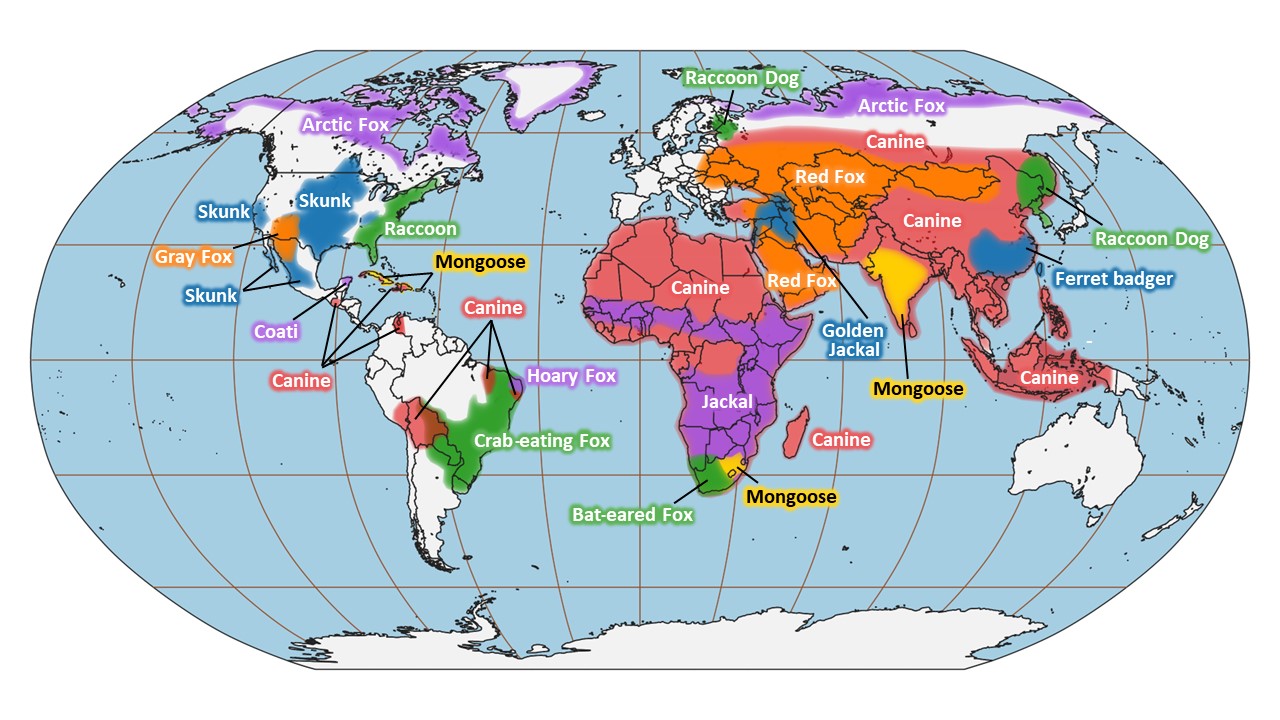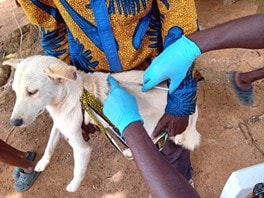Key points
- Every year, rabies kills 70,000 people worldwide.
- Dogs cause 99% of human rabies deaths outside the U.S.
- If you’re traveling internationally, learn more about rabies at your destination and find out how to protect yourself.
- CDC collaborates with global partners to support rabies elimination and control efforts across the globe.

Overview

While rabies prevention and control programs and access to post-exposure prophylaxis help manage rabies in the States, rabies kills around 70,000 people worldwide every year. More than 99% of human rabies deaths outside the United States are related to dog bites or scratches, but other animals also pass on rabies to people. In certain parts of the world, wildlife like bats, foxes, jackals, mongooses, skunks, and others transmit rabies, too.
Many countries have not looked for rabies in local wildlife, and it is likely that yet-undetected wildlife also maintain the virus.

What CDC is doing
World Rabies Day
World Rabies Day is celebrated each September 28 to raise global awareness about rabies prevention and honor Louis Pasteur, who developed the rabies vaccine. Despite being 100% preventable, nearly 70,000 people die from rabies each year. CDC collaborates with many agencies and organizations to promote World Rabies Day worldwide.

CDC's global work against rabies
CDC and its partners across the globe work to enhance rabies prevention, tracking, and control in both people and animals. CDC provides training programs to help improve diagnostic testing, surveillance, and dog vaccination campaigns.
CDC also helps educate communities around the world so that they can identify rabies symptoms and respond to animal bites.
Guinea

From 2023 to 2024, Guinea made significant progress towards improving national rabies control activities, thanks to a collaboration between CDC, the nonprofit Mission Rabies, Guinea National Directorate of Veterinary Services (DNVS), and many other local partners.
In total, more than 180,000 animals (mostly dogs) were vaccinated across 10 high-risk communities. The Guinea team used the Worldwide Veterinary Service app to document key information about the animals, which helped experts at CDC better identify communities at higher risk for rabies, give guidance for vaccination campaigns, and conduct a post-vaccination evaluation.
The app allowed CDC staff to provide real-time assistance on campaign management. The results showed that nearly 70% of the dogs were vaccinated, which is the percentage necessary to stop rabies from spreading in dogs in any community.
Haiti

Haiti has the highest rate of human deaths from rabies in the Western Hemisphere. In the years after a massive 2010 earthquake devastated Haiti's rabies control program, CDC estimates that more than 100 people died from rabies each year.
CDC worked with the Government of Haiti and the International Rabies Taskforce to implement a community-based program that works with bite victims to find the animal that bit them. Then, they use veterinary assessments and diagnostic testing to help bite victims decide if they need additional medical care.
In April 2024, one of Haiti's rabies experts was called to respond to a dog that had bitten a young child in the face. After a search through the community, the dog was found and tested positive for rabies. This information was critical in convincing this family to seek out rabies vaccination, which can cost the bite victim as much as 3 months' salary. Each year, this program helps more 2,000 bite victims make important decisions about rabies vaccination.
Partners in rabies control
The rabies program at CDC serves as a World Health Organization (WHO) Collaborating Center, a World Organization for Animal Health (WOAH) Reference Laboratory for Rabies, and a founding partner of the International Rabies Taskforce (IRT). As a WHO Collaborating Center and WOAH Reference Laboratory for rabies, the CDC provides diagnostic services to rabies-endemic countries and provides technical support to countries to achieve rabies elimination.
The IRT is a public-private partnership with the organization Mission Rabies and vaccine manufacturer MSD Animal Health. Under this umbrella, the organization assists rabies-endemic countries with mass dog vaccination campaign planning, implementation, and evaluation. They also improve rabies surveillance using the Rabies Exposure and Contact Tracing (REACT) App. As a result of this partnership, more than three million dogs have been vaccinated against rabies, and more than 100,000 rabid animals were investigated.
To achieve the goal of eliminating rabies deaths by 2030, the CDC has established partnerships with many organizations and health ministries around the world. Key collaborators in this global effort include:
- Boutelle, C., Mollentze, N., Gigante, C. et al. A logistic regression model to predict the next rabies virus host-shift event. Sci Rep 15, 19306 (2025). https://doi.org/10.1038/s41598-025-98986-x
